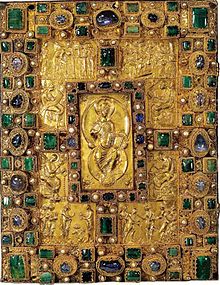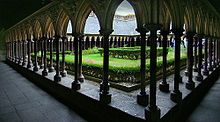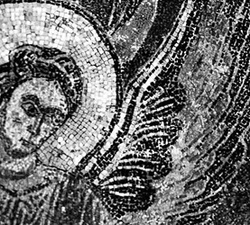Good, Evil, and Just Plain Medieval
The Middle Ages birthed the Medieval arts. The Medieval arts contained elements of architecture, scupltures, and paintings. During this time period the chruches were the art's biggest patrons, as seen in the creation of numerous monestaries as well as the iconic religious paintings. Medeival art can be subdivied into specific genres including but not limited to Early Christian art, Migration Period art, Byzantine art, Romanesque art, and Gothic art.
Medieval art came about and remained approximately between 300-1350. The Renaissance directly followed from about 1350-1580. With that in mind at some point styles and techniques in the field of art during these two periods blurred together. However, nowadays Medieval art is considered more elementary; Renaissance art really began to focus on visual accuracy not only with the human body but with an emphasis on focal points and direction. Untrained eyes can lead a viewer to believe that Medieval art is just as exquisite as seen in the picture below titled The Effects of Good Government. This painting was done with the popular techinique of the time, fresco and was located in the City Hall of Siena created byAmbrogio Lorenzetti, towards the end of the era in 1338.
Medieval art came about and remained approximately between 300-1350. The Renaissance directly followed from about 1350-1580. With that in mind at some point styles and techniques in the field of art during these two periods blurred together. However, nowadays Medieval art is considered more elementary; Renaissance art really began to focus on visual accuracy not only with the human body but with an emphasis on focal points and direction. Untrained eyes can lead a viewer to believe that Medieval art is just as exquisite as seen in the picture below titled The Effects of Good Government. This painting was done with the popular techinique of the time, fresco and was located in the City Hall of Siena created byAmbrogio Lorenzetti, towards the end of the era in 1338.

More than just architecture and paitnings the Medieval art era was famous for the use of other mediums like mosaics, metalwork and stained glass.
Here is the jewelled cover of the Codex Aureus of St. Emmeram, c. 870, which was create with stones in a tile like application to cover a Carolingian Gospel book.
Here is the jewelled cover of the Codex Aureus of St. Emmeram, c. 870, which was create with stones in a tile like application to cover a Carolingian Gospel book.
Here is a beautiful example of what the Medieval artist could produce with the mosaic medium.
This located at Germigny-des-Prés (Church of la Sainte-Trinité).
This located at Germigny-des-Prés (Church of la Sainte-Trinité).

The Medieval arts also participated heavily in the lesser or "minor arts," which consisted of things like ivory carving and embroidery.
This Ivory plate was created in Paris in 1300 carved with relief soley out of ivory.
This Ivory plate was created in Paris in 1300 carved with relief soley out of ivory.

Medieval architecture encompassed aspects of both religion and military. It ranged from cathedrals and monestaries to castles and fortresses. This time period focused on the use of solid stone foundations as wells as arcs and piers as seen in Cloisters of Mont Saint-Michel, Normandy, France.
Renaissance architecture focused more on symmetry and proportions like that of the Romans.
Renaissance architecture focused more on symmetry and proportions like that of the Romans.
Most imformation and images were located on Wikipedia.


